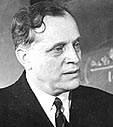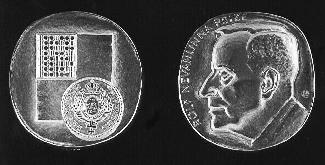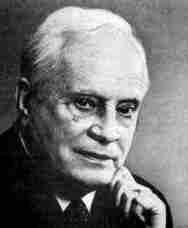 The website is in construction. New files will be uploaded as soon as they are available.
The website is in construction. New files will be uploaded as soon as they are available.
ROLF NEVANLINNA
Joensuu 1895 - Helsinki 1980

- Brief scientific biography
- Contributions to Education
- Essential bibliography
- Publications on the teaching of mathematics
Brief scientific biography
Rolf Nevanlinna was born in Joensuu, Finland, on 22 October 1895. The grand duchy of Finland was then a part of the Russian empire. The extraordinary talent of the Nevanlinna family (earlier also called Neovius) has abounded through centuries. The Neovius-Nevanlinna lineage has produced dozens of mathematicians and school teachers of mathematical sciences, several of whom have also been known as authors of successful mathematics textbooks. Rolf Nevanlinna's interest in the teaching of mathematics certainly stems from the family legacy.
Rolf Nevanlinna's grandfather, Major-General Edvard Engelbert Neovius, taught mathematics and topography at a Russian military academy and conceived a pioneering approach to SETI, Search for Extraterrestrial Intelligence. Rolf's father, Otto Neovius (from 1906 Nevanlinna), was a physicist and mathematician. He married Margarete Romberg, daughter of Herman Romberg, the German chief astronomer of the Pulkova observatory in St Petersburg, so that Rolf was of German, and indeed Prussian, descent on his mother's side. Rolf's elder brother Frithiof also became a well-known mathematician. Moreover, Otto Nevanlinna's cousin was Ernst Lindelöf, an eminent professor of mathematics at the University of Helsinki and the would-be mentor of both Rolf and Frithiof.
The young doctor Otto started his career as a school teacher of physics and mathematics at Joensuu, a rural town far away from the capital. In 1903, the family, with four children, returned to Helsinki where Rolf entered a grammar school which emphasized Greek and Latin. He was hesitant at first as to whether he should pursue classical studies at the university but Ernst Lindelöf's example soon convinced him of his true calling, which was to be Analysis.
In December 1917, in the aftermath of the Russian revolution, Finland declared independence. The following spring, the country was torn by a bloody Civil War which opposed Red and White Guards. The Reds were supported by revolutionary Russia, whereas the Whites received military assistance from Germany. The young Rolf joined the White Guards but did not see much military action.
Frithiof Nevanlinna received his doctorate in 1918 and his brother Rolf received his in 1919, both in the field of Complex Analysis. Immediately after completing his dissertation, Rolf married his cousin Mary Selin but this marriage ended in divorce. In 1958, he married his second wife Sinikka Kallio. He was to have five children.
Nevanlinna established his worldwide fame as a leading complex analyst during a three-year period of intensive creation in 1922-25. Together with Frithiof, he created the 'Nevanlinna Theory', or the value distribution theory of meromorphic functions. Despite their eminent research contributions, none of the Nevanlinna brothers held an academic position. Rolf taught mathematics at a school for about twenty hours a week, whereas Frithiof was employed by an insurance company where he later hired Rolf as well. In his memoirs Nevanlinna states that his school teaching took up most of his time but the evenings, weekends and holidays were devoted to research.
In 1926 Nevanlinna, then 31, finally received a professorship at the University of Helsinki. His best student, Lars Ahlfors, created a sensation in the mathematical world in 1928 when he proved, at the age of 21, the Denjoy Hypothesis. Ahlfors was awarded the Fields medal in 1936. Nevanlinna visited Zürich and Paris together with Ahlfors. During the term 1936-37, he visited Göttingen, where Oswald Teichmüller attended his lectures.
The so-called Winter War broke out when the Soviet Union invaded Finland in November 1939. A curious episode of this period is André Weil's visit to Rolf Nevanlinna. Weil, who carried visiting cards signed N. Bourbaki, was suspected of being a Soviet spy and was arrested by the military police. After Nevanlinna and other mathematicians had testified in his favour, Weil was released and expelled to Sweden. During the war years, Nevanlinna did research in ballistics for the improvement of field artillery firing tables. He was awarded the Cross of Liberty, Second Class, for his services. Finland having mounted a heroic resistance to the Red Army, a precarious truce was signed between Finland and the Soviet Union in March 1940.
Faithful to his Prussian origins and a certain military aspect of his upbringing, Rolf Nevanlinna played a political role during the truce, campaigning for a Finnish-German alliance in case of a new war. In 1941, the year of Operation Barbarossa, which Finland joined, Rolf Nevanlinna was elected Rector of the University of Helsinki, an eminent public position which marked the end of his most fruitful research period.
On the insistence of Germany, Finland had to recruit a volunteer corps for the German armed forces, which, moreover, was to be incorporated into the SS and not into the Wehrmacht, as the Finns would have preferred. The issue was politically delicate because, on the diplomatic front, the Finnish government - which remained democratic throughout the war - did everything possible to avoid full collaboration with the Nazis, aiming to wage a separate war with the Soviet Union, but not with the Western Allies. A suitable private person was needed to handle the recruitment of the politically burdensome SS troops. The Finnish government decided to put Rolf Nevanlinna's well-known German sympathies to good use. In 1942, at the request of the Foreign Minister, Nevanlinna made himself available as chairman of the Finnish SS Volunteer Committee. In this role, Nevanlinna rubbed shoulders with SS brass and was awarded the German Eagle with diamonds.
Having successfully opposed an armed resistance to the Soviet onslaught in the summer of 1944, Finland opted out of the World War and again signed a truce with the Soviet Union in September 1944, losing some territories. At this point, the political winds turned and Nevanlinna was portrayed as a Nazi collaborator by the Finnish left-wingers. On the Prime Minister's advice, he had to step down from the Rector's office. He accepted a position at the University of Zürich instead, occupying a chair where he succeeded his former student Ahlfors, who had moved on to Harvard.
Official Finland did not abandon Nevanlinna, however. When the Academy of Finland was founded in 1948, Nevanlinna was elected a member despite fierce opposition from leftist quarters. The government justified the election pointing out that Nevanlinna's wartime action had been in accordance with Finland's official policy and the interests of the state. In particular, anti-Semitism had not been part of Nevanlinna's pro-German ideology. The Soviets were quick to rehabilitate Nevanlinna; they did not try to block his election to the presidency of the International Mathematical Union (IMU) for the four-year term 1959-62. Nevanlinna was the president of the International Congress of Mathematicians (ICM) held in Stockholm in 1962, and he also chaired the program committee of the Moscow ICM of 1966.

In the ICM of Warsaw in 1983, the IMU established the Rolf Nevanlinna Prize to recognize work on mathematical aspects of information science. The Finnish-Swiss Rolf Nevanlinna Colloquia also perpetuate his memory.
Contributions to Education
In his quality of President of the IMU, Rolf Nevanlinna served as an ex officio member of the executive committee of the ICMI in 1959-62. As we have earlier stated, teaching of mathematics was close to Nevanlinna's heart because of his family's long-standing commitment to this field. He was known as an inspiring lecturer, and he had a special ability to convey the sense of aesthetics of the mathematical experience.
In an increasingly specialized academic world, Nevanlinna insisted much on the unity of Western Culture and the usefulness of practising Arts and Sciences together. "There are no Two Cultures; there is only one", he famously commented on C.P. Snow. His public lectures on topics such as general relativity or the foundations of geometry were sometimes attended by cultural figures, including poets and composers. Nevanlinna often cited the view of Jacob Burckhardt, who claimed that, besides a civilized person's main profession, his life should involve another interest that was more than just a hobby. In the case of Nevanlinna, music was such a passion. He was an amateur of the violin and a somewhat fanatic aficionado of Jean Sibelius's music; if he was not happy with the performance of an orchestra, he would go and tell the conductors. He also served as the chairman of the board of Sibelius Academy.

We can learn at least one thing from all that has happened in mathematics during these decades of vast expansion: this period proves, if anything, the great significance, both in principle and substance, of the Euclidean elementary system. This theory has always stood out as the ideal of exact science. But the present century has experienced a peculiar revival of this basic mathematical theory, which has shown enormous vitality in two different main directions: it has given impetus to the revolution in mathematics represented by the break-through of the axiomatic mode of thought, and this has had fruitful effects in the most varied branches of mathematical and logical research. But it has also, in a more substantial respect, undergone an unforeseen revival through the generalizations it has allowed in infinite-dimensional Euclidean geometry, Hilbert-space and its applications.Politically, Nevanlinna was a staunch conservative and a right-winger throughout his life. When student radicalism spread to the campuses in the 1960s, Nevanlinna developed a grudge against the "abstract theoreticians of pedagogy" who had allowed this to happen. His constructive response to the demands of the youth movement was the creation of the so-called 'Presidential Working Group' in Finland. Under the leadership of President Urho Kekkonen, this working group prepared a famous report, on the basis of which a law for the development of Finnish tertiary education was enacted in 1966. The new legislation was far-reaching in its effects, leading to the creation of several new universities. Since the 1950s, Nevanlinna also was one of those who advocated equipping the Finnish universities with computers, thus heralding the birth of Information Society whose successful champion today's Finland has become.
In view of all this it is amazing that a group of enthusiasts supporting a radical reform of school mathematics have mustered around the slogan 'Down with Euclid!' How can anything as narrow as this ever be suggested and, furthermore, by people who without doubt deserve credit for notable contributions to contemporary mathematical science?
The matter cannot be dismissed merely as a joke in bad taste, even on the assumption that the slogan has been coined mainly with a view to creating a sensation.
Essential bibliography
O. LEHTO 1998, Mathematics without borders: A history of the International Mathematical Union, New York, Springer
O. LEHTO 2001, Korkeat maailmat. Rolf Nevanlinnan elämä (in Finnish: "The Lofty Worlds. The Life of Rolf Nevanlinna"), Helsinki, Otava, to appear in: German translation published by Birkhäuser
R. NEVANLINNA 1925, Zur Theorie der meromorphen Funktionen, Acta Mathematica, 46, 1-99
R. NEVANLINNA 1929, Le théorème de Picard-Borel et la théorie des fonctions méromorphes, Paris, Gauthier-Villars et Cie
R. NEVANLINNA 1936, Eindeutige analytische Funktionen, Berlin, Springer-Verlag
R. NEVANLINNA 1953, Uniformisierung, Berlin, Springer-Verlag
R. & F. NEVANLINNA 1959, Absolute Analysis, Berlin, Springer-Verlag
R. NEVANLINNA 1976, Muisteltua (in Finnish: "Souvenirs"), Helsinki, Otava
Publications on the teaching of mathematics
R. NEVANLINNA 1966, Reform in teaching mathematics, The American Mathematical Monthly 73 (5), 451-464
Author
Osmo Pekonen
Universities of Jyväskylä and Helsinki - Finland
pekonen@mit.jyu.fi
